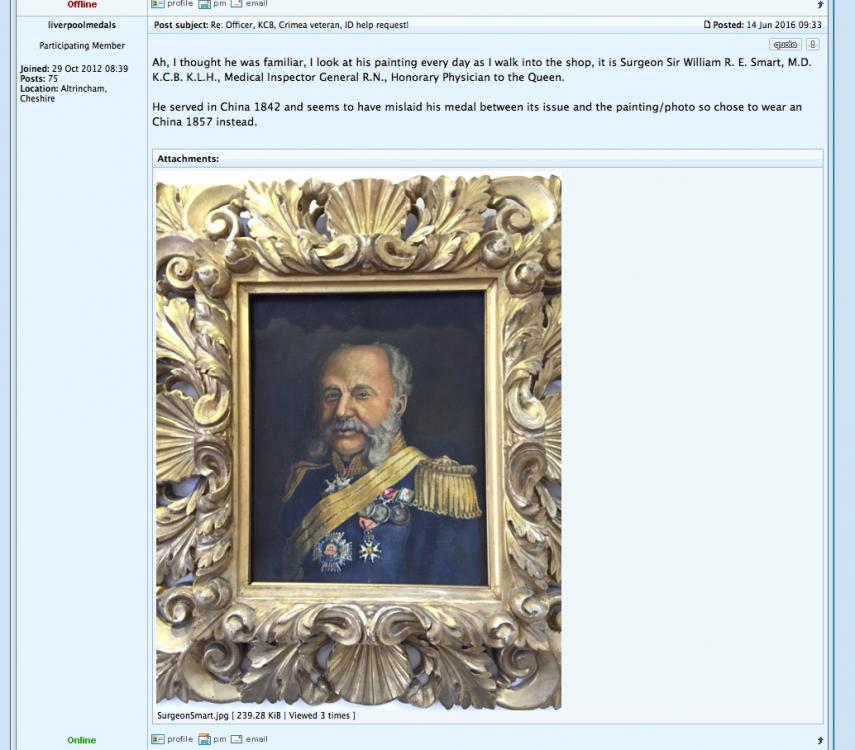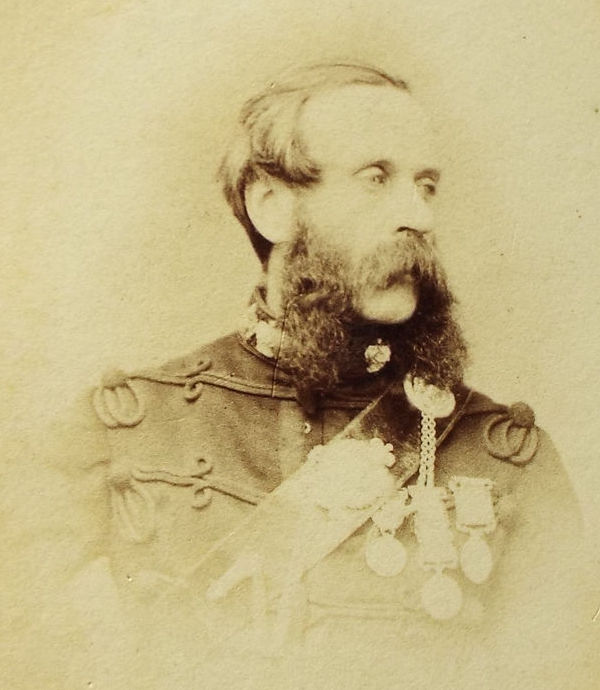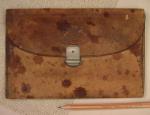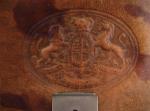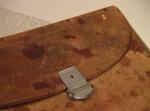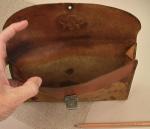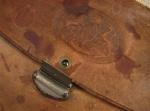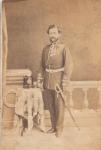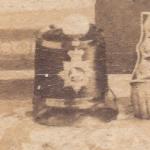-
Posts
38 -
Joined
-
Last visited
Content Type
Profiles
Forums
Blogs
Gallery
Events
Store
Everything posted by mikehm
-

A Victorian Admiral?
mikehm replied to mikehm's topic in Great Britain: Militaria: Badges, Uniforms & Equipment
Well, what do you know? On another forum is a man who owns an oil painting based on the photograph. He writes: It follows that the sash must be either (a) indicative of an RN Medico, (which seems unlikely, as we would otherwise see them much more frequently) or (b) indicative of an appointment as Hon. Physician to the Queen (my best guess at present). I am not sure I will ever forgive Smart for wearing a Second China suspension on his First China Medal (or a complete Second China Medal, if that is what he has done). It makes the task of identifying sitters by their medal entitlements very difficult if they wear the wrong medals! -

A Victorian Admiral?
mikehm replied to mikehm's topic in Great Britain: Militaria: Badges, Uniforms & Equipment
After the wild distribution of hundreds of Légions d'honneur during the Crimea, the French were far more parsimonious in the Second China War. I don't have RN figures to hand, but I know that only five awards were made to the Army, so the chances are very high that the award was for the Crimea. Yes, it may be that a rosette is missing, but I am loath to start guessing what might be missing, as that way lies madness: a missing Mejedie would open the field up wonderfully! He may not even have had a CB in the Crimea (I'm betting he didn't: men with CBs usually picked up two or three foreign awards), but I have run out of candidates before I even start looking at the Order of the Bath. Someone must know what that unprintable sash is, and I bet it is important . . . -

A Victorian Admiral?
mikehm posted a topic in Great Britain: Militaria: Badges, Uniforms & Equipment
Dear All, I am flummoxed; even more so than when I was trying to identify the Rifle Volunteer uniform I posted yesterday. Please correct me if I am wrong, as I surely must be, but this looks to me to be the uniform of a senior officer of the Royal Navy, wearing a sash I don't recognise, together with the insignia of a KCB; a Crimea Medal (reverse showing); a Second China War Medal without clasp (obverse showing); a Turkish Crimea Medal with a replacement suspension; and the breast badge of a Knight of the French Légion d'honneur. Although apparently a photograph of an engraving, the detail of the medals is so precise that I find it unlikely in the extreme that it is not an absolutely faithful portrait of someone - but who? Of the officers of the Royal Navy who received the fifth class of the Légion d'honneur, only 26 failed to receive another foreign order. According to Kevin Asplin's published roll, only one of these served in China and earned a Second China War Medal: Surgeon Richard D. Mason, RN. He, however, received a clasp for Canton 1857, (and does not appear to have been knighted) so can be ruled out of contention. It seems that I have successfully ruled out every possible candidate. One of my assumptions must be wrong. Which is it? What is that sash, anyway? Is he an RN officer at all? Help, please! ATB Mike -
Yes, that was why I jumped to the conclusion that he was an RB officer, but he cannot be (or at least not by the time this picture was taken). No RB Colonel earned that medal combination without also picking up a foreign order (I checked), and, besides, the RB did not wear shiny rank badges. This must be an RV uniform. As for the judge, that was exactly my thought! It reminded me of this Not the Nine O'Clock News sketch: ).
-
Dear All, Attached is a recent acquisition. I bought it under the misapprehension that the uniform was that of the Rifle Brigade, but no Rifle Brigade Colonel had this medal combination, and the RB wore black rank insignia, not bright metal, on their collars. An officer of Rifle Volunteers, then, wearing Turkish Crimea, three-clasp Crimea, and what may be a South Africa 1853 medal. The photograph was taken by celebrated Chelsea pornographer* Claude Bossoli, (which implies a Middlesex Corps), and probably dates to 1865-67. Rank badges were only worn on the collars of patrol jackets by Field Officers in the regular army, but I am not sure how true that was of the Volunteers, and his sleeve lace is out of sight. Is he a full Colonel, or a mere Captain? Can anyone identify the uniform, or even perhaps the sitter? Thanks in advance for any assistance anyone may be able to offer. ATB Mike * Bossoli was sentenced to 12 months hard labour for selling "grossly obscene photographs . . . at a very low price" in 1871! If nothing else, this gives a latest possible date for the photograph.
-
Dear All, There is an amount of confusion surrounding the question of the services of this unit, as the following units existed, and served in South Africa during 1899-1902: No. 11 General Hospital, Kimberley - under the command of Lt. Col. M. D. O'Connell, RAMCNo. 11 Stationary Hospital - under the command of Major D. R. Hamilton, RAMCNo. 11 Brigade Field Hospital - under the command of Major John Brew Moir, RAMCNo. 11 Field Hospital (RAMC) - under the command of Lt. Col. D. L. Irvine, RAMCNo. 11 British Field Hospital - initially under the command of Lt. Col. Sidney Herbert Carter, RAMC, and latterly under the command of Major John Kearney, RAMCHaving drawn almost a complete blank from traditional (to me) sources, I wonder if someone here might have some information on the service of the last-mentioned unit, which was formed in India, included officers from both the RAMC and the ISMD, and served in the Tirah Expedition as well as in South Africa. I learn from an on-line article about the Indian Ordnance Department that "The transport Henzada with No.3 field medical stores depot, No. 11 British field hospital, and Ordnance field park . . . left Calcutta, 20th September (1899) and arrived on October 14th 1899 at Durban." Members of the unit received Queen's South Africa Medals with clasps for the Defence of Ladysmith and Laing's Nek as well as for Belfast, Elandslaagte, Transvaal, Orange Free State, Cape Colony and Natal. Can you help fill out the picture, or suggest sources I might consult? I have recently acquired the medal of Pte. Henry Lane, 1/DCLI, who was a member of this unit, and served with it during the Defence of Ladysmith and the engagement at Laing's Nek. ATB Mike
-
Many thanks, Eric. Having had a look at illustrations on the WWW, I see what you mean. It's a dead ringer for a Mark VII, cupronickel jacketed, .303 bullet - the WWI Lee Enfield round. At its narrowest, where it has been squeezed, it mic's at 0.307"; at its fattest, it is 0.317". I think it probably started life around 0.310" or 0.312" - and .312" is exactly the diameter of a British .303 bullet, and much too small to be a 7.92 Mauser round. Presumably, then, this is something faked up for the tourist market? This is Baldrick's "bullet with his name on it"!
-
Dear All, I couldn't resist this when it popped up on eBay the other day - an 1897 penny with a bullet stuck halfway through it. The bullet is a jacketed round, 33mm long, with a diameter ranging from 7.80mm to 8.04mm according to digital callipers. The jacket looks to be steel, but is completely non-magnetic. No obvious rifling marks are visible, but there is evidence that the base of the bullet has been deformed by pliers or some other gripping tool - perhaps the result of an attempt to remove it from the penny, which has had a suspension loop added to it. So, is this 7.92mm ammunition from a K98 Mauser rifle, and, if so, can it be dated to the Boer War, the First World War, or the Second World War? If not, can anyone identify it for me? ATB Mike
-
Dear All, Does anyone know of a professional researcher working at the NRS reading room in Edinburgh? I need a look-up in the records of the Forfar Militia for 1807 ( http://catalogue.nrscotland.gov.uk/nrsonlinecatalogue/details.aspx?reference=SC47%2f72%2f4&r=sc47%2f72 - for a John Tindal, who volunteered on 2nd September that year to 46th Foot, and who earned an MGS with clasps for Martinique and Guadaloupe). Not that I have the faintest idea of what these records contain, but I can but hope for an age and place of birth, and maybe an occupation and residence as well. As a volunteer, he signed up for a specific length of service, was discharged time expired in 1821, was therefore not entitled to a pension, so there are no WO97 or WO121 files for him. Sadly, there seems to be nothing in WO96 either.
-

Mystery Victorian Wallet or Pouch
mikehm replied to mikehm's topic in Great Britain: Militaria: Badges, Uniforms & Equipment
Thanks for that, Mervyn. It is not quite wide enough for the size of the official paperwork of the time (foolscap folded across its width twice), and there is no obvious method of mounting it on a belt or strap - the back has no loops or hooks, nor any sign that any were ever present. The spring-clip would make it uncomfortable to carry in an inside pocket. I have no idea! -
Dear All, I spotted this on the US eBay site, and couldn't resist it. It is a little soft leather wallet or pouch with a white-metal spring catch, and a gusset in one side-seam, bearing the Royal Arms of Queen Victoria blind-stamped into the flap. It is 5" x 7.75" - about the size of a paperback book. Is it diplomatic? Military? Private property of the Queen? Has anyone ever seen one before? Does anyone know what it was for? If not, would you like to take a guess? http://gmic.co.uk/uploads/monthly_01_2015/post-17308-0-63153600-1420801764.jpghttp://gmic.co.uk/uploads/monthly_01_2015/post-17308-0-58306700-1420801779.jpghttp://gmic.co.uk/uploads/monthly_01_2015/post-17308-0-21901300-1420801799.jpghttp://gmic.co.uk/uploads/monthly_01_2015/post-17308-0-70530600-1420801815.jpghttp://gmic.co.uk/uploads/monthly_01_2015/post-17308-0-39883000-1420801831.jpg Looking forward to hearing your thoughts. ATB Mike
-
Having recently acquired the medal group of ENSA dancer and singer Pauline Guy (who performed as Pauline Gaye) - 39-45, Africa, France & Germany, Defence and War Medals - I have been doing some digging into these questions. The following is mostly drawn from information contained in Greasepaint and Cordite, by Andy Merriman. Between 1939 and 1946, ENSA put on 2,565,656 cinema shows and theatrical performances to an audience estimated to be in excess of 500,000,000. ENSA members performed from Iceland to Burma, taking in NW Europe, Germany, West and North Africa, the Middle East and the Indian sub-continent. Given the demands upon it, it is unsurprising that its live performances were not always of West End quality, and it came in for a great deal of underserved criticism as a result. No-one paused to reflect that whilst they seemed to expect every ENSA member to be Gracie Fields, or John Geilgud, or George Formby, they did not expect every soldier to be Monty, or Wavell, or Slim! The man who ran it, Basil Dean, was so unpopular that ENSA was denied a place amongst the civilian organisations in the Victory Parade in London in 1945. It was not until the RBL permitted civilian organisations to march in the Remembrance Day parade in 2000 that ENSA veterans were at last recognised for their contribution to the war effort. I have no data (yet) on the number of ENSA members deployed to theatres of war. Entitlement to campaign stars and medals as one of the "specially approved civilian categories" is confirmed in War Office publication code WO1911, paragraph 9, sub-paragraph (d) "N.A.A.F.I. (Overseas)" as "Entertainments National Service Association (E.N.S.A.)" There is no dedicated museum, archive, or other centre for information about ENSA. One ENSA member was killed during the war. Nineteen-year-old dancer Vivien Hole (stage name Vivienne Fayre) was travelling in a lorry which hit a landmine in Holland in January, 1945. The blast took both of her legs off, and she died en route to a field hospital. She is buried in the Sittard War Cemetery, Limburg.
-
Dear All, It has just come to my attention that the leaf containing pp. 463 and 464 in my copy of Wyrall's The Duke of Cornwall's Light Infantry 1914-1919 has been neatly cut out with a knife! Would some kind soul who has a copy of this work please be kind enough to scan these two pages for me? I would be very greatly obliged. Many thanks in advance, Mike
-

Unidentified Name that VC-winner!
mikehm replied to mikehm's topic in Great Britain: Research, Documentation & History
According to contemporary newspaper reports, Moynihan was selected by his company to receive the French War Medal [sic], and was invested with it at Horse Guards, on 20th May, 1856, by Lord Hardinge. I cannot imagine how his name has been omitted from all the published rolls ever since. -

Unidentified Name that VC-winner!
mikehm replied to mikehm's topic in Great Britain: Research, Documentation & History
Update: this must be Lt. (later Captain) Andrew Moynihan, VC, 8th Foot, late 90th Foot. According to his entry in The VC and DSO, quoting the last entry in Hart's Army List before his death in 1867, he had the Médaille Militaire. I cannot find any trace of it being awarded, so he may have awarded it to himself, but at least we have an ID. -

Unidentified Name that VC-winner!
mikehm replied to mikehm's topic in Great Britain: Research, Documentation & History
It seems I can cut-and-paste in a reply, so this will have to do! This infantry Lieutenant of around 1860 is wearing a VC, a Crimea Medal with at least one clasp, an Indian Mutiny Medal (with no clasp?), a French Médaille Militaire and a Turkish Crimea Medal. It follows that he served in the ranks in the Crimea. The photograph is on thin card, with the mark of "J. Gresty's Photographic Studio, Dock St., Fleetwood" [Lancashire] on the back of the mounting card. I have tried to work out who he is myself, but I am having problems. I went through the 1860 Army List, looking for infantry Lieutenants with VCs commissioned after 1853, and then checked their names against the recipients of the French Médaille Militaire. No luck. Then I went through the list of foreign awards for the Crimea in the back of BB&M, generated a short-list of recipients of the Médaille Militaire who also received a VC for the Crimea, and checked to see who was commissioned into an infantry regiment. One man was - but he was first commissioned into a cavalry regiment, and did not join the 104th Bengal Fusiliers until 1871. Besides, he had a multiple-clasp Crimea Medal. So, not Charles Wooden, then. Double-checking the presence of the photographer, John Gresty, in Dock Street, Fleetwood, the earliest I can confirm him there is 1872, and he remains there until at least 1891. He was born in Manchester around 1841. In 1865, he was in Chester, publishing his own illustrated guide books, so the print must be a little later than I first thought. But can the image be as late as all that? That pattern of tunic was superseded in 1868, and that pattern of shako in 1861, so presumably not. So if the image is no later than 1861, and it can certainly be no earlier than 1859, assuming that really is a Mutiny medal. Even if that is not a Mutiny, the earliest it could be is 1856, so my c. 1860 date seems pretty secure. The massive enlargement of the shako seems to suggest the badge of the 14th Foot, rather than the 6th or 8th, but whilst that regiment was in Crimea, and did earn single-clasp medals, as well as half-a-dozen Médailles Militaires, it did not deploy to India for the Mutiny. Could that last medal be a New Zealand? Yes, conceivably - and the 14th were there from 1860 to 1866. Sadly, as far as I can see, though, none of their officers had VCs. I thought I was on to something there for a moment. Looking at the Dress Regulations, the only regiments who were permitted animals rather than numbers on their shako plates at this time were: 2nd Foot - Lamb 3rd Foot - Dragon 4th Foot - Lion 6th Foot - Antelope 8th Foot - White horse 14th Foot - White horse + nec aspera terrent I can see no sign of the flag carried by the lamb of the Queen's, and the extended forelimb here points downwards, unlike those of the dragon of the Buffs, or the lion of the King's Own. The regiment surely has to be one of the other three. I have double-checked the Army Lists for 1860, 1863 and 1865, and the only VC-winner in 6th, 8th or 14th Foot is Andrew Moynihan, VC, who had a single-clasp Crimea, a Turkish Crimea and a no-clasp Mutiny, was promoted Lieutenant in 1857, but who did not have the Médaille Militaire. I am stumped. Does anyone have any bright ideas (or corrections for mistaken assumptions) for me? -
I have a huge amount of text to post as background to this, but I have forgotten what the workaround is to persuade this board to accept pasted text, and I cannot find the help file that explained it. While I keep looking, here is a VC winner's portrait from about 1860. Anyone know who he is? Oh, and if anyone knows how to paste text here, please let me know.



